History
Chapter 1: A Criminal Mastermind
It all begins in 1993, when a fig wearing very cool shades steals an even cooler yellow race car.
This TV spot was produced in 1993 by Advance, Lego's chief ad agency. In 2012 they provided some commentary on the production:
This was shot in Los Angeles and features a storyline that generated a lot of Grand Theft Auto-type controversy. It features a thief called Max who steals a car and is pursued through the city by police. In the end he escapes and we see the police precinct set from above. There were no CGI effects here -- everything was built from scratch.
While evidently controversal in the conservative Lego offices of the 90s, Max was seemingly considered enough of a hit that he returned the following year, in 1994. Now he's a cowboy.
Advance also adapted this '94 spot for the main lego catalog of the year, turning it into a framing narrative for all the minifigure-based playthemes. Max, now known as Max Timebuster, is fleeing through the different lego worlds and times, stealing random objects as he goes. It becomes a small 'where's waldo' game to find him in the different dioramas.

see the whole catalog courtesty of brickset
On its own, this story already has the foundations of the Time Cruisers product line story - a modern-day minifig hopping around to the other contemporary Lego themes and doing stuff with the special pieces from them. But the most overt precedents were actually left on the cutting room floor:
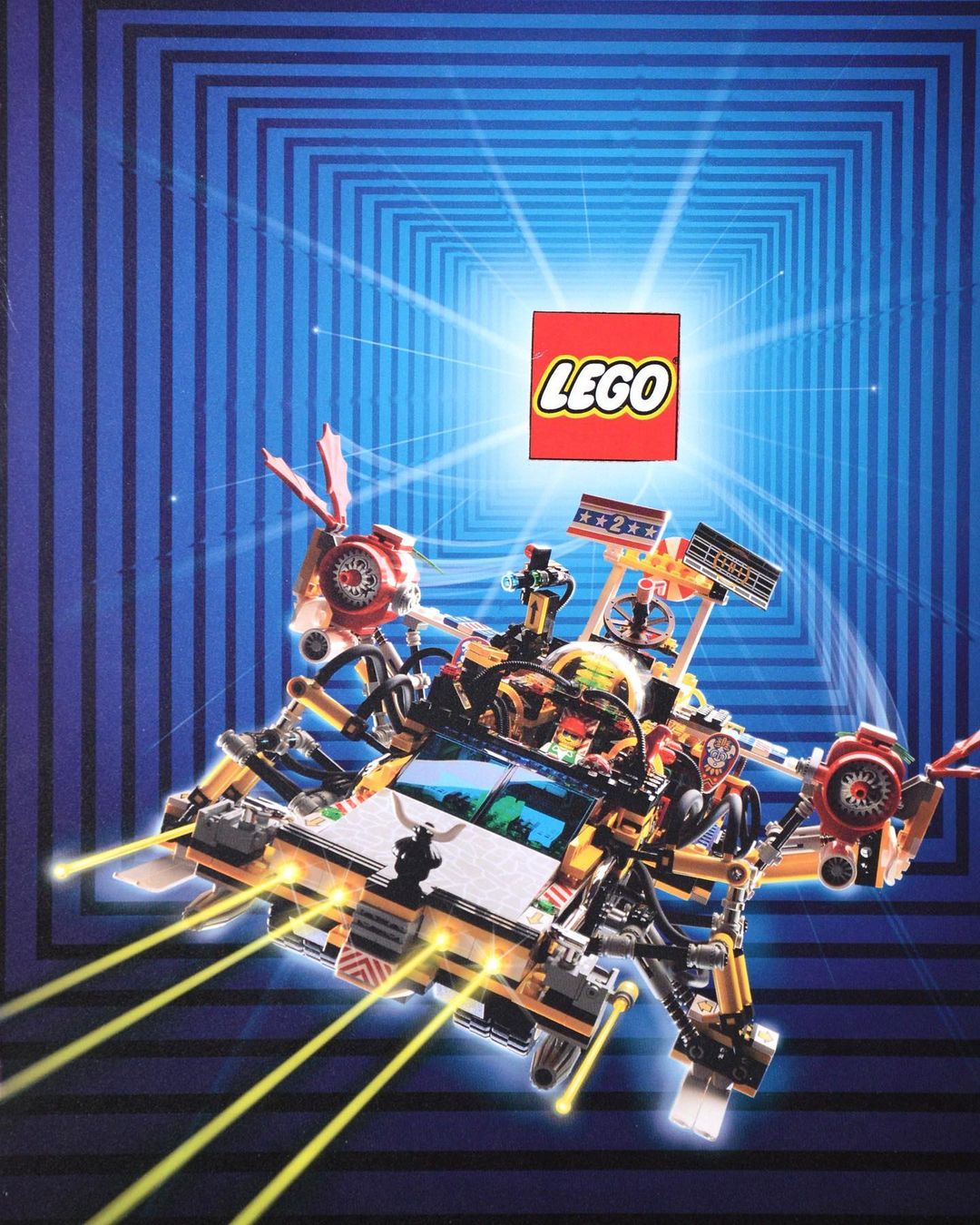
This original time machine was the work of Christian Faber, an art director at Advance. While he went on to be most remembered for his contributions to Bionicle, Faber had a hand in the look and story of many Lego themes in the 90s. He posted photos of the time machine to his personal instagram, alongside some commentary.
To celebrate one of my favorite 80ies film legends and the fact that a super #lego version of the #backtothefuture #delorean is released, this is a flashback to 1996 [sic] when I did the early concept of the #timecruiser. I build this model using parts from all the models of the 1996 [sic] assortment to make a vehicle that could travle through the entire brochure. It became the start of the #legotimecruisers line. The flat front of the Delorean is mirrored by a roofplate from #legoparadisa and the cruiser has all kinds of details and functions. Here you see Max in the TC navigating the tunnel of Lego time. Where we are going you need no building instructions

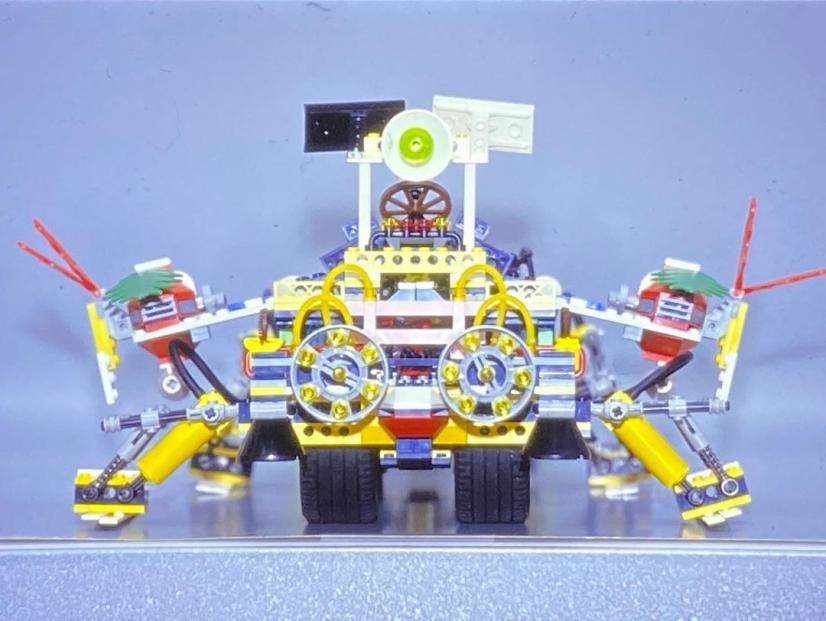

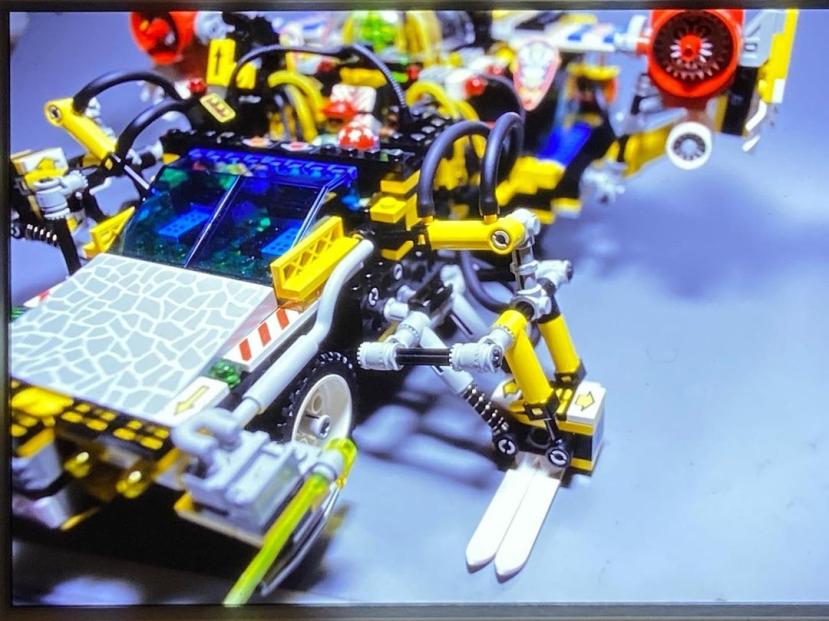
My friend Juniper suggested that this time machine might have been the culmination of Max's thievery throughout the rest of the catalog; combining all of his stolen goods into a machine that mashed all themes together. I'm partial to this theory, especially since the base of the model looks so familiar. Its larger now, but a yellow car like this was just what Max stole in his first appearance... and the wings of the time machine even match the plane Max reconfigures the car to in the first commercial. If you looks closely, you can also see Max has his stolen briefcase from the 1994 commercial safely stashed with him in the cockpit. This is a time machine built on years of criminal enterprise.
While Max falls out of the mainline Lego/Advance marketing materials after 1994, this was not quite his end...
Chapter 2: Everything Klicks
A major branch of the Lego marketing machine in the 80s and 90s were magazines/Lego Clubs - for a small fee or sometimes for free, children could subscribe to a magazine that promoted the Lego brand, encouraged creativity in building, and featured contributions from children. Increasingly over the 80s, these mags also served as ad vehicles for new lego product lines. These mags were at the time organized separately by different regional teams/agencies, with Ole Primdahl at Lego in Denmark serving as the coordinating head. Annemette Allerup was copyeditor for Klick, a magazine produced for Lego by an agency called Courage. In an exchange with Sadie shared over the course of this RRU thread, Allerup went into detail about the mag's background.
A trip down Memory Lane:
Unfortunately, I just moved and on that occasion threw out my stack of LEGO magazines but they must have them in the advertising department in Billund, DK. They – under the leadership of Ole Primdahl – gave me the assignment. [...]
Originally it was an assignment for testing in Switzerland in the 80s. Because LEGO had realized that there was a decline of interest in LEGO bricks with a great number of kids (boys mainly at that time) once they turned 6 or 7, started school and other activities, they wanted to create a kids’ magazine with some of the same educational values as LEGO – a magazine that indirectly should support the different LEGO universes. This became the KLICK magazine which was marketed in Switzerland for a few years. KLICK had stories about visiting a space centre in the US, about going on a boat ride (not many boat rides in Switzerland), about aeroplanes, cars and other things from real life that indirectly related to LEGO universes of that time. We also had a small cartoon, I don’t remember the name, and a relative small part of promotion for new LEGO products.
KLICK was well received and tested fine but due to wrong marketing it never became the magazine success LEGO had hoped for. They both asked for subscriptions and handed out free issues at events so naturally they did not reach the number of paying subscribers they had anticipated. The project was closed after I don’t remember how long, maybe 2 yrs.
(emily's note: there's still nothing online im aware of documenting this original swedish edition of klick, if you know anything hit me up)
4-5 years later however, a marketing man revived the idea of having a magazine that could keep the 6-8 yr old boys interested in their LEGO, get the bricks clicking for a longer time in the kids’ rooms, make LEGO stay on the wishing list for Christmas and birthdays. This time the project started in Austria and again, was intensely tested before launch. The editorial concept this time was far more clearly focused on LEGO – the magazine was initially named LEGO Explorers – for curious and creative LEGO fans, and it brought storytelling about seasonal LEGO launches as well as some educational background stories about i.e. ancient Egypt, the Middle Ages, Underwater exploring etc. clearly linking to the different LEGO products.
It was in the development of this new Austrian edition of Klick, debuting in 1995, that Max Timebuster once again snuck onto the scene. While it wasn't used in the final catalog from 1994, Faber's time machine design was evidently passed around Lego internally, and reached Primdahl. Allerup relates how this spawned a comic, with the contributions of artist and author Kim Hagen:
Ole Primdahl showed [the time machine] to me and we decided to use it for a cartoon in the magazine because it made it possible to travel from one LEGO universe to another in an exciting way. It also supported the idea of combining bricks from different universes. Together we described the opportunities of the concept, but the character and cartoon was creatively developed in cooperation with Kim Hagen whom I had hired for a free lance artist for the magazines.

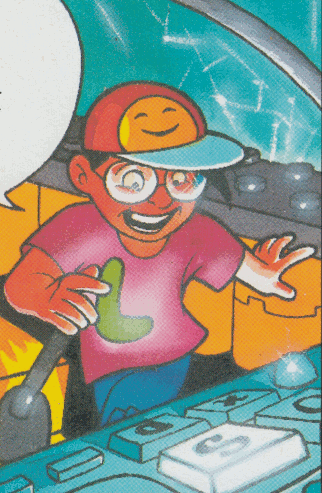
Left: Test art by Hagen of Max and the time machine. Right: Max as he first appears in the comic.
In the development process for the comic, Max Timbuster was retooled. No longer a cool, grizzled adult, he became a Relatable Child. In a riff on the time machine's DeLorean inspired design, the youthful Max was given a Doc Brown to his Marty McFly: a Freud-looking fellow by the name of Professor Nockelberg.
Notably, the comic leaned into Hagen's cartoon art style, derived from his training under Don Bluth. Nockelberg and the new Max were not minifigures, and couldn't be built in a recognizable fashion out of the existing minifigure parts of the day. Hagen describes the style in this way...
The drawing style is partly based on the new wave of American superhero comics, which place a lot of emphasis on extreme action and pacing in the pages. In addition, a cartoony element has been added to make the drawings more child-friendly.
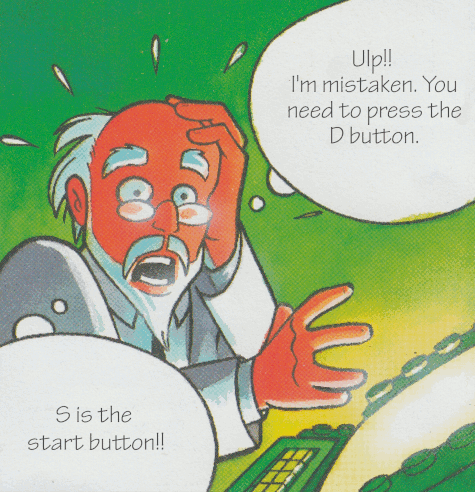
Professor Nockelberg.
Not exactly a thief, the child Max gets his start when he accidentally activates the newly constructed time machine of Nockelberg, his grandpa. In a test for the first installment, shared via a snapshot taken by Hagen, Max irresponsibly climbs into the machine, causing this disaster. The final comic adjusts this to make it all Nockelberg's fault.

Regardless of whose fault it was, the new Max was off on his adventure through time, and would continue to visit a handful of Lego themes through the remainder of 1995. Changes were already on the horizon, though...
Chapter 3: Time Cruisers Real
By Allerup's account, the Timebuster comic was a rousing success, and was a key incentive for Lego HQ to develop a product line for 1996: "Time Cruisers as a theme was definitely inspired by the good response from the cartoon in the magazines." Lego made a number of adjustments to the concept as they shaped it for their purposes. Chiefly, Max and Nockelberg were no longer Max and Nockelberg. It's not hard to see what happened with Max - Lego would have been conscious of the fact many children would still remember the cool adult Max of a couple years earlier. So the child Max Timebuster was renamed Tim Time Cruiser to differentiate him. Lego chose to give Tim colors matching the original Max as opposed to comic Max, a cute nod to his origins. The L on child Max's shirt in the comic (presumably standing for 'lego') also becomes a T (presumably for 'Tim' or 'time'). So, sadly, its a lot harder in the modern era to make jokes about Tim taking the L.
It seems Lego was comparatively less concerned about the integrity of Professor Nockelberg's character. He takes a Freudian slip downward into becoming Dr. Cyber, a kooky mad-scientist type who doesn't visually bear much resemblance to the source material outside of the labcoat and facial hair. Nockelberg wasn't exactly a character of much depth anyway, so taking him in this direction makes about as much sense as anything else.
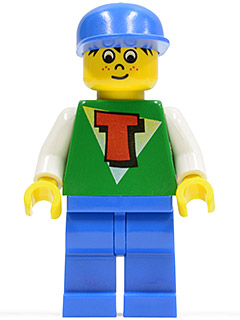
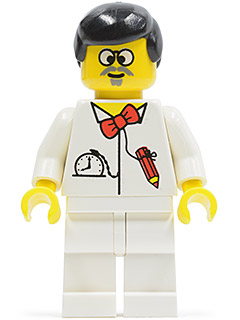
File photos of minifigure Tim and Cyber from bricklink
One of the most notable features of these figs, notorious to AFOLs of the time, are their unusual faces. Minifigures normally have simple black dot eyes, with the convention of white highlights being added to the formula in the 2000s. The Time Cruisers figs experimented with the reverse, adding full whites around the black dot eyes. Additionally, Tim was given a nose - scandalous! In retrospect it seems obvious that this was an attempt to mimic the style of the comic, using the crude toolset available to Lego graphic designers of the time. This context was lost on general audiences like AFOLs, who were unaware of the comic's existence.
The Time Cruisers models themselves generally took after Faber's original time machine model, though none could match its scale at a reasonable retail price. I would argue the purest 'true descendent' of the original machine is the Navigator 2025, a car-ish thing with dual windscreens, a front engine, and dragon wings. The star of the show though was undoubtably the Flybo 2025, a wacky flying pirate ship.
Lego also expanded the cast of characters with Ingo, a funy monkey, and Wacco, a funy robot. Further, the line expanded with a new cast of 'villain' Time Cruisers in 1997. The Time Cruisers product line prompted multiple regional marketing campaigns that took the Time Cruisers story in their own unique directions, but these are beyond the scope of this writing for now. I recommend RR Slugger's video series for those curious for more.
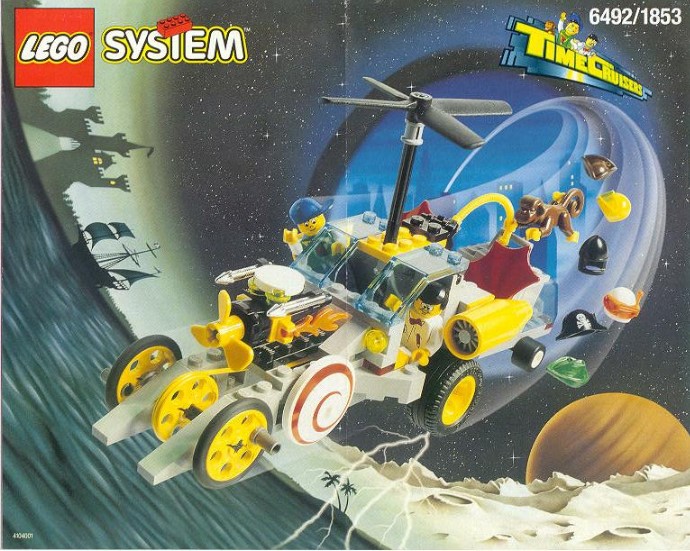

Left: Navigator. Right: Flybo.
Allerup and Hagen found themselves tasked with adapting the changes from Time Cruisers into their fledgeling Timebuster comic. They eased the transition over the course of the first two 1996 issues:
- January: The L on Max's shirt becomes a T. He stops using the name Max, introducing himself as just 'Timebuster' instead.
- March: Timebuster's shirt is now green instead of purple. A magical explosion transforms the original time machine into the Flybo (simply called the Time Cruiser in Germany). I know this makes no sense but Timebuster decides that in commemoration of this new machine, he needs a new name that starts with a T. He chooses Tim and becomes Tim Timebuster.
At the end of the year, in December, the comic's Western arc ends with Tim meeting a Crime Monkey whom he adopts as his own. He names the monkey Ingo going into 1997 (or Ali in Germany, Kikol in France). Wacco, the robot from the sets, never appears in the comic. This might be a deliberate choice, as robots from other themes (Spyrius, Exploriens, UFO) are also conspicuously absent.
Finally we come to poor Professor Nockelberg. His name change is not accounted for, for reasons described in the next chapter. He only became Dr. Cyber in name - in appearance and manner he remains exactly the same. Unlike Tim, he was never adjusted to better match the minifigure. That said, I do like to think Professor Hydronis, from 1998, was mocking the Cyber minifigure's wacky design.


Left: the evil one. Right: Hydronis.
Having successfully adapted the comic to the theme, you might think it would be smooth sailing for Allerup and Hagen going forward. Well... :)
Chapter 4: Fractured Timelines
At the same time the Time Cruisers theme was taking shape, things were changing fast for Klick. The success in the Austrian market prompted expansion into other territories, unprecedented for Lego magazines at the time. Allerup recalls the process.
[...] the project was extended to more countries firstly Switzerland and France, later Germany. The magazine was issued in different languages – makes a great difference for the puzzles and riddles – and for the organization of local promotions and copromotions.
The Austrian magazine was tested with regular intervals – group interviews with kids were done to adjust (rather few) editorial mistakes. Same procedure was carried out in the French speaking countries Switzerland and France – some local differences resulted in local adjustments.
Localization presented a conundrum for Timebuster as well. Since the magazine was starting in France and Switzerland contemporaneously to the Time Cruisers theme, in 1996, they made an editorial decision. Rather than summarize the story that had gone before exclusively in Austria, a new two-page intro was made that replaced the original time machine with the Flybo from the get-go. This intro could then be slotted in before whatever most recent world Tim had zapped to in the ongoing comic, producing a relatively seamless transition for new readers. See alt intros for more on this. As the project grew, the oroboros ate its own tail:
But then Germany wanted to launch a proper club project and the magazine became front runner of the LEGO World Club project which enhanced also visits to LEGOLAND Germany and a number of direct selling and merchandising activities. Again intensive research was carried out regularly – and all showed that receiving and reading the magazine stimulated playing with own bricks and wishing new ones immensely.
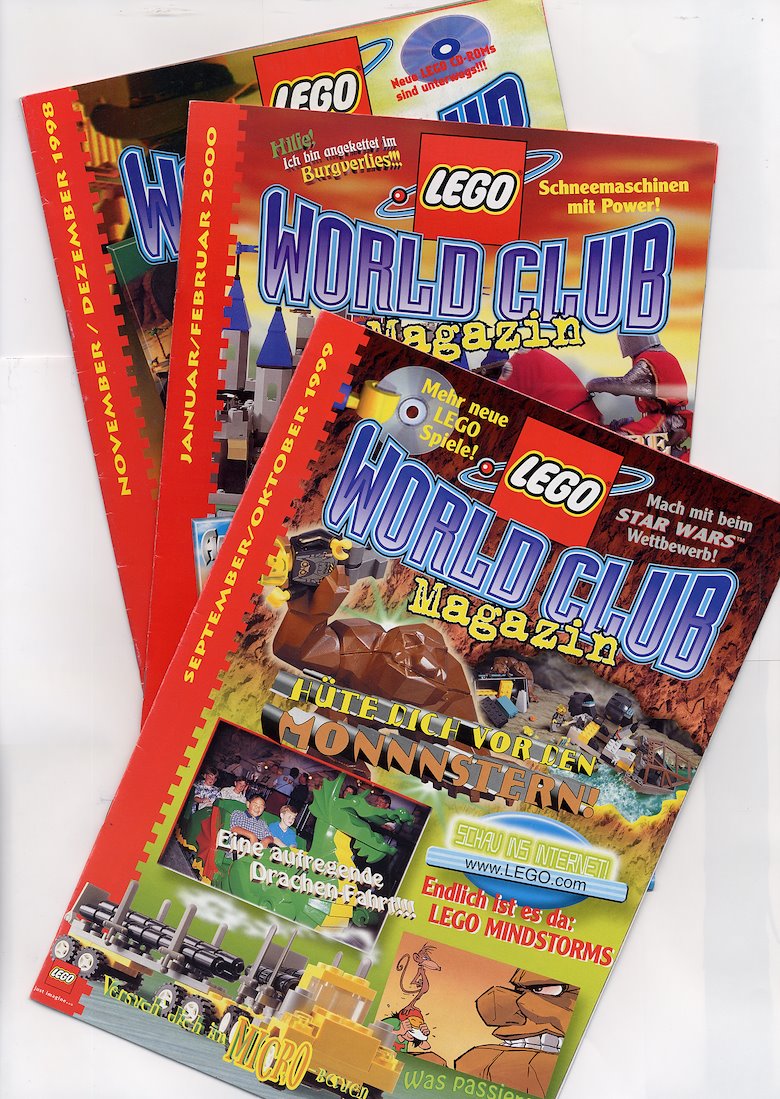
While the magazine itself was virtually identical, the overall project of Lego World Club was much greater in scope than Klick, overriding it. The German World Club Magazine, beginning in 1997 with the intro featuring the Flybo and Dr Cyber, subsumed the Austrian Lego Klick, meaning there was never any in-story explanation for Nockelberg's name change. And there continued to be slippages - the German World Club initially introduces Tim as Tim Time Cruiser, in line with the theme, but immediately slips back into calling him Tim Timebuster. Additionally, the new intro was still made before Ingo was introduced - meaning in regions such as Germany, the monkey simply appears without explanation when Tim arrives in a new time period.
The decision was made to further streamline the comic, in part to address these concerns. Hagen composed an explanatory document that defined the direction and parameters of the comic from September 1998 onward, where he writes that
They never go back to old worlds and old characters are not revisited in later episodes. The reason for this is that the series started at different times in different countries, so certain worlds and characters were never introduced to a large group of readers. It also makes it easier for new readers to get into the series.
This document also refers to Dr. Cyber as Tim's uncle, differing from his original role as a grandfather. He is never described as an uncle in officially published material. You can find the original Danish version of this doc in the very funny Blogspot it came from here, and I've got a (deepl) English translation here.
I can't argue that these new no-continuity rules must have made life a lot easier for Hagen and Allerup, and made the comic more immediately accessible to kids of the day. But my opinion is that they also make 1999 onward much more of a bore to read today - nothing of long-term interest happens. The final continuity shake-up was a second and final revised introduction, which removed the now retired Flybo set in place of a stationary time machine. From there, Tim aquires a handheld zapper that clicks onto any lego set and makes it travel through time - ensuring the time vessel at hand would always be relevant and toyetic going forward. Again, alt intros for more.

The final time machine.
By this point, the Timebuster comic, rechistened Time Cruisers, had outlived the theme that based itself on it by several years. But changes loomed once again on the horizon. From Allerup:
The [World] Club Magazine [...] was adapted by several other countries – amongst others, in the Far East – so I’ve seen it in a Korean version! Rather funny! I believe we reached printing in a [total] number of 13 countries.
LEGO World Wide however, had a wide range of other magazine and club projects so around yr 2000 or so, it was decided to collect them all in one organization in the US.
Lego World Club, which itself had consumed some of the regional Lego Magazines such as Bricks n' Pieces in the UK, was itself consumed in the process of uniting the magazine projects worldwide under the organization of Lego's US office and their club magazine. As Allerup recalls, by 2000 some mags still had unique names, but they all shared their content with the US's Mania Magazine. In 2002, the transformation was complete as all mags worldwide unified under the simple title, "Lego Magazine."
The Timebuster/cruisers comic therefore found itself on the chopping block in 2001, with its final issue featuring the Studios theme. This was the true end of Tim. While the official English translation fumbles here and still asks you to tune in for a continuation next issue, the German localization is more deliberate. Without saying goodbye, it avoids promising more, instead inviting the reader to continue the story themselves - "where will the two of them zap when the movie ends?" The closing black circle also gestures to the fact this is the conclusion.

Conclusion
The Timebuster comic didn't leave much of a legacy. It's rediscovery in 2013 spawned a cult following consisting of the ~13 or so of you who are reading this, but ultimately it was never to be known even so much as the short-lived Lego theme it birthed.
I've enjoyed my time with Tim, though. Its been a rewarding project to work on translating, then scanning, his adventures over the years, and I hope my work here has been entertaining and informative to you. We may not know where Tim is out there now, but something tells me he is still zapping through time, facing danger after perilous danger without ever communicating to the responsible adults in his life that he's safe. Such is the life of a time buster...
until next 'time'!
~emily
Bonus Zone - The Miscellany
Here's some bonus stuff related to the comic I don't know where else to put.
Behind the Scenes
A small feature from World Club showing what Hagen's working environment was like in 1998.
German, Hi res: Page 1, Page 2
English, lo res: Page 1, Page 2
Poster
A poster from the Klick era, scan from Hagen's online portfolio. Content warning, this has one of the super racist depictions of Poly people in it. Link
How-to-Draws
In the latter years, Hagen contributed a few 'how to draw' segments to World Club.
German, hi res: Tim, Ingo, polar bear????
English, low res: Tim, polar bear????
No Letters
A couple Trains pages without lettering/bubbles, from Hagen's portfolio.
Portfolio Misc
Selected highlights Hagen grabbed from the comic for his portfolio. Some are recolored from the originals.
Arctic Guy, 'fright' knights dragon, evil cruisers, rock raiders, firefighter dude, "ho!", baby of immense zoological interest
